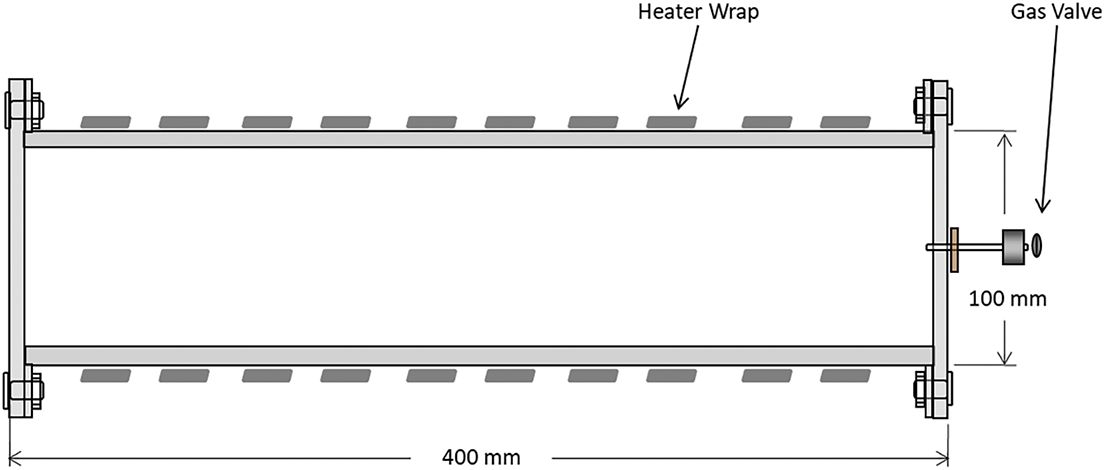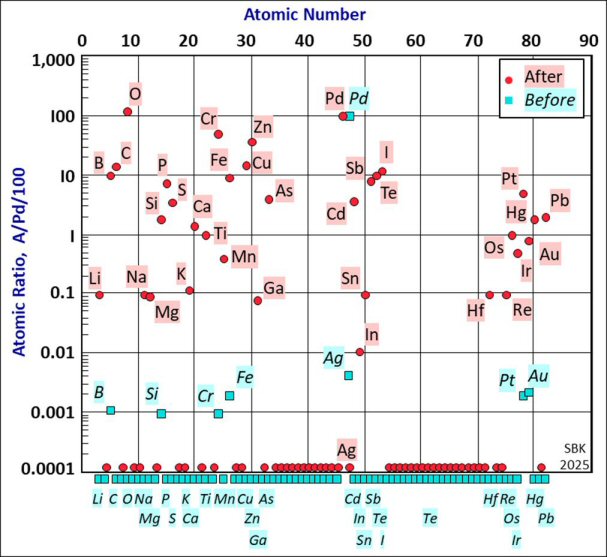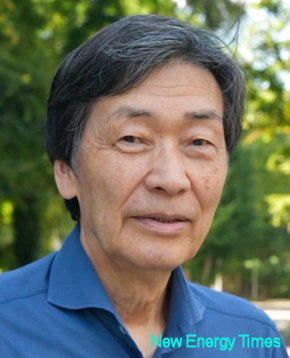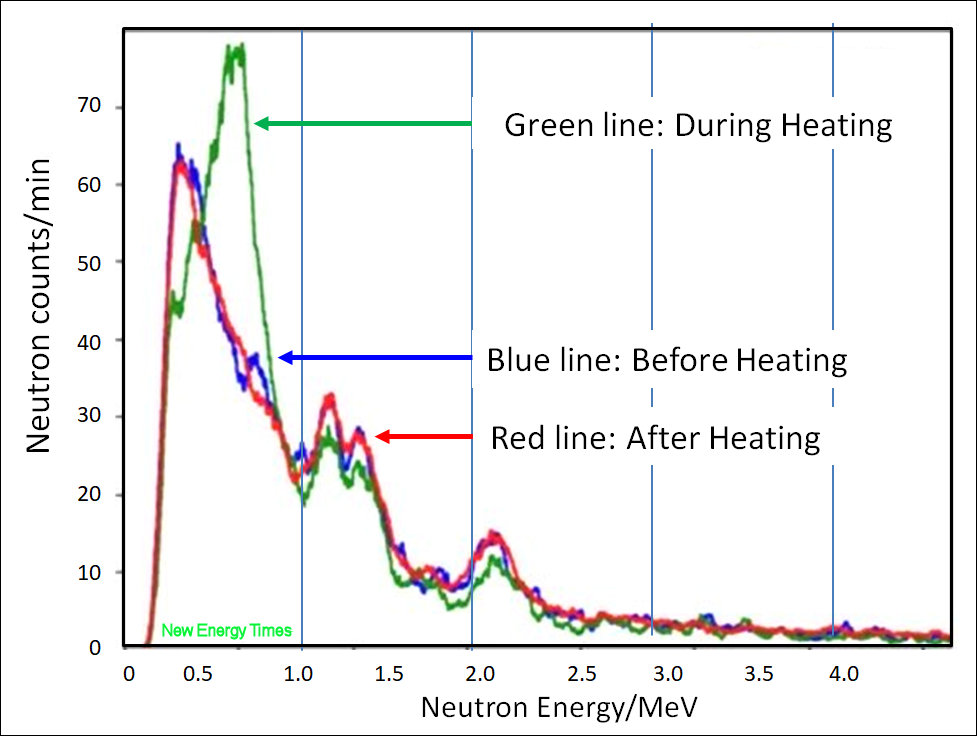Editor’s Note: At the time of the Fleischmann-Pons fusion announcement, electrochemist Dr. Melvin Miles was working at the Naval Air Weapons Center at China Lake, California. Within a week of that announcement, as Miles explained to me, he was invited to give a lecture at the commander’s meeting to all the top people at China Lake and explain to them what was going on, what the prospects were, and what the problems were. Miles applied himself to seek answers to those questions, to the best of his ability, from that day onward, through the rest of his life. I was fortunate enough to see him last year and conduct a lengthy video interview and he will be featured in an upcoming film. – Steven B. Krivit
(Republished with permission. Original published Oct. 21, 2025 at “Remembering My Uncle, Dr. Melvin H. Miles: The Navy Scientist from Utah Assigned to Examine Cold Fusion”
By Jeff Lindsay
Nov. 20, 2025
As we approached the home of my uncle, Dr. Melvin H. Miles, in St. George, Utah, my wife and I noticed a small placard at the side of his door that we had never seen anywhere else: “Cold Fusion Is Real.” I was skeptical, based on what I had heard as a young chemical engineer, but wanted to learn. Two hours after we sat with him and asked about his years of research work for the Navy, we would hear that phrase again. After summarizing his findings, he looked me in the eye and said, “Either cold fusion is real, or I’m a liar.” From a good man noted for his frankness and honesty, this was a powerful statement.

Melvin Miles in 1991, St. George, Utah (Photo: J. Lindsay)
That was in early 2025, the first of five interviews I had with him discussing cold fusion. My last visit was on Oct. 7, 2025. He passed away on Oct. 20 at the age of eighty-eight. In some of his last words to me, he asked me to publish some of his story and his message. I’d feel driven to write even if he hadn’t asked me. This Latter-day Saint man was raised in Utah and, after a challenging mission in Germany, he received a B.S. in chemistry at BYU and a Ph.D. in physical chemistry at the University of Utah, where he studied under Dr. Henry Eyring, a renowned physical chemist. What he found and experienced in his career may be valuable not just for Utahns or Latter-day Saints, but for the scientific community and many others.
At the time of our first visit, I did not yet know that he was viewed as an important figure of the LENR (Low-Energy Nuclear Reaction) community, an international group that was largely spawned by the cold fusion controversy over thirty years ago and the desire to learn more about strange nuclear events that can happen outside of a high-energy nuclear reactor. I had not yet read his many papers nor his fascinating autobiography on his cold fusion research, available at LENR?CANR.org.
As an aside, I must note that “cold fusion” is likely an incorrect term. The strange phenomena that many “cold fusion” researchers observed likely do not involve actual fusion at all, but LENR phenomena arising from low-energy neutrons that can enter and modify the nuclei of nearby atoms, according to what is called the “Widom–Larsen theory.” It remains a controversial proposal that may be the best explanation so far for many experimental results around the globe in this field. See the outstanding historical review by Steven B. Krivit in Explorations in Nuclear Research, vol. 1, Hacking the Atom (San Rafael, CA: Pacific Oaks Press, 2016). Nevertheless, I will use the term “cold fusion” because that is how it was described during the primary years of Miles’s research and is the term he continued to use in our conversations, though he emphasized that the mechanism is still unclear.
Miles’s quest to understand the truth regarding cold fusion began just hours after a press release on March 23, 1989 from the University of Utah:
‘SIMPLE EXPERIMENT’ RESULTS IN SUSTAINED N-FUSION AT ROOM TEMPERATURE FOR FIRST TIME
SALT LAKE CITY — Two scientists have successfully created a sustained nuclear fusion reaction at room temperature in a chemistry laboratory at the University of Utah. The breakthrough means the world may someday rely on fusion for a clean virtually inexhaustible source of energy.

Melvin H. Miles with Jeff and Kendra Lindsay, March 2025, St. George, Utah
The announcement and the more detailed press conference that day featured the key scientists, Stanley Pons and Martin Fleischmann. They discussed a novel process generating high energy from heavy water, where deuterium (D), a heavy hydrogen isotope with one proton and one neutron, replaces normal hydrogen (H) in H2O. In some unknown nuclear process, the interaction of the metal palladium with deuterium liberated from water by electricity led to energy release that the scientists proposed might be from fusion of the deuterium atoms in or on the palladium. The energy released was greater than the electrical energy put into the system to split heavy water into oxygen and deuterium gases, giving “excess heat,” a potential source of energy. If fusion could take place under such tame conditions, one might predict that mankind was on the verge of a vastly more abundant world due to low-cost energy.
The promise of that discovery has not yet been realized. In fact, interest in and funding for related work would be decimated shortly after the announcement. The scientific establishment, government funding agencies, and the popular media quickly and confidently denounced cold fusion as an irresponsible and embarrassing fiasco from two Utah scientists.
Miles would soon be in the thick of the controversy, first as a skeptic, and later as a “believer” after he found a way to replicate the essence of what Pons and Fleischmann had seen. He would go even further by being the first to discover the production of helium–4 in a cold fusion cell when excess heat was also being produced—a dramatic telltale sign that some kind of nuclear fusion process was involved. And he would continue publishing numerous noteworthy reports, including two important papers in 2024 and 2025 in his late eighties.
When cold fusion was announced, Miles was working as a Research Electrochemist for the Naval Air Weapons Center (NAWC) at China Lake, California. He had been working to improve thermal batteries used in missiles, along with other projects requiring his skills in physical chemistry and electrochemistry. He learned of the cold fusion announcement on the radio the next morning, a Friday, while driving to work. He also found a voicemail from his department head, Geoff Lindsay (no relation), asking him to look into cold fusion and see if it was real. If so, there could be many important military applications.
Miles jumped at the opportunity and came in the next day, a Saturday, on his own time to begin exploring the possibility of cold fusion. It would be the first of many weekends he sacrificed for cold fusion. He used palladium electrodes, heavy water, and other items already on hand. This would begin one of the most important and challenging aspects of his life. He would not have official funding for three years, but with support of his supervisor, he pursued cold fusion “on the back burner.” Unfortunately, his early experiments failed to replicate what Pons and Fleischmann reported. After months of exacting work, he published a paper indicating that he never saw any indication of excess heat being produced. He was a skeptic.
Many other scientists (but not all) who sought to replicate cold fusion also failed and became skeptics. A few weeks after the Utah announcement, a flock of physicists at the annual meeting of the American Institute of Physics went far beyond the bounds of science by not only declaring cold fusion was a mistake, but by also denouncing Pons and Fleischmann. While negative reports and articles proliferated, Miles felt there must be more to understand, for Pons and Fleischmann were highly respected experts.
Suspecting that the properties of the cathodes might be critical, he tried an unusual source of palladium for a cathode in his electrolytic cell (“electrolysis” is using electricity to split a molecule like water into components such as oxygen and hydrogen or deuterium for heavy water). When it had run for a few days, excess heat suddenly began to be generated. He was still cautious and would need to rule out potential sources of error, but he began to realize that cold fusion might be real. He would later say that he “only gradually became convinced” by his own data.
The Problem With Cold Fusion
The problem with cold fusion in its early days was that it was very difficult to reproduce (it is still often challenging today). It could take weeks for the reactions giving excess heat to initiate. Since the mechanism was not understood, it was impossible to know what needed to be controlled. A new palladium source was the key, for it turned out to be an ideal version low in oxygen. Two electrodes cut from the new palladium rod would give excess heat time after time. But other rods from the same vendor could still fail. Other important factors would include contaminants in the system, the loading of deuterium into palladium, the applied current, and even humidity in the lab. Cold fusion is complex, making failure easy.
Pons and Fleischmann knew about the complexity. These two internationally recognized chemists, both experts in electrochemistry at the top of their field, had been working secretly at the University of Utah since 1984 on their highly speculative project. Based on others observing puzzling phenomena involving palladium and hydrogen, they wondered if densely packed deuterium in palladium might be driven to achieve a form of nuclear fusion in an electrochemical cell. Many of their trials showed nothing of interest. But after years of work, they began to have enough success that they dared to consider publishing their results, though there was still much to learn.
Their visionary experiment used heavy water that was made electrically conductive with the addition of a lithium salt. The applied current in the cell drove a reaction that caused heavy water to split into deuterium gas on the palladium cathode and oxygen gas on the platinum anode. They monitored the electrical energy going into the cell and the energy that the cell released to its environment. Normally the energy in should equal the energy out, but sometimes they found anomalies in which significant excess heat was created that could not be explained by normal chemical processes. They believed that the only way to explain this was that some unknown nuclear reaction taking place.
The challenges in reliably reproducing and understanding cold fusion were not the only trouble they faced. A physics professor at Brigham Young University (BYU) in nearby Provo, Utah, Steven Jones, learned of their work as a reviewer selected by the Dept. of Energy to confidentially review a proposal from Pons and Fleischmann for funding. Jones saw their work as related to his own experiments in which he believed that subatomic particles might catalyze the release of neutrons in metal when immersed in heavy water, indicative of a nuclear reaction. While he did not believe that excess heat could be generated and would quickly become a sharp critic, at the time he saw value in collaboration.
As detailed by Eugene F. Mallove in Fire From Ice (1991), after Jones reached out to Pons and Fleischmann, the University of Utah saw Jones as a threat seeking to claim credit for cold fusion, putting potential patents and revenues at risk. University attorneys pressed for a quick press conference to reduce the risk of BYU edging into their territory, but this meant the University of Utah professors could not share detailed information before related patents were filed. This would lead to charges of doing “science by press conference” and being unethical for not freely sharing details. The awkward circumstances of a premature announcement created lasting trouble for the scientists.
Things got worse when other scientists, unimpressed by the seemingly questionable press conference, concluded that Pons and Fleischmann were contradicting science. Chemistry professor Nathan Lewis of the California Institute of Technology (Caltech) presented negative results from brief experimental work claiming that cold fusion did not work; he then castigated Pons and Fleischmann. The Baltimore meeting was a turning point that many thought meant the death of cold fusion. Scientific journals and the popular press would accept their accusations and heap more criticism upon the beleaguered chemists. The two eventually left the U.S., finding no hope for their careers there.
Meanwhile, a panel composed almost entirely of skeptics was assembled in April 1989 by the Department of Energy. They were asked to issue a final report on cold fusion. The panel moved quickly and by November 1989 they published a statement declaring that they could find no evidence that cold fusion was of any significance. The panel managed to complete their work without visiting Miles or talking with Fleischmann. To Miles, the DOE report, which effectively crushed funding from multiple agencies, didn’t look like science.
Were Conflicts of Interest Behind the Rush to Reject Cold Fusion?
I asked Miles what motivated so many to reject cold fusion so quickly. With his typical cautious approach, he said he didn’t know for sure, but could offer some possible reasons. These can essentially be summarized as conflicts of interest.
For the many physicists whose funding came from hot fusion or nuclear fission projects, they faced a threat of reduced funding and prestige if an inexpensive new technology from the “lowly” halls of chemistry suddenly upended their world. This might explain much of the opposition of the physics community. In “Dr. Mel Miles’ Autobiography for His Cold Fusion Research,” written with the help of Tom Grimshaw and Ruby Carat in 2022, part of the LENR Research Documentation Initiative, Miles said the following about the 1990 International Cold Fusion Conference in Salt Lake City:
That was … the strangest scientific conference I ever went to. Critics were trying to influence the press that was there, by using terms you’d never use in a scientific conference, things that related to ridicule after a speaker spoke….
We had about a 50/50 mixture of people who had positive results and critics that came to ridicule. We had hot fusion people from MIT that wanted to shoot down the cold fusion idea…. And anytime anybody had a positive talk, one of these negative people would jump up and they would just make statements of ridicule….
A lot of press was there, and they were just playing to the press. I’ve never seen a scientific meeting where a person gives a positive talk, and then somebody jumps up and tries to use ridicule, and ridicule would be the right word…. I began to realize that it was hot fusion people trying to protect their interests….
Their whole careers are based on getting government money year after year on this never-fulfilling promise of useful energy from hot fusion. Government funding sustained their careers, so they have to continue receiving it. Of course, they would fight against cold fusion getting accepted. Maybe I’d do the same, but I don’t think so…. I don’t blame them, but that’s not scientific.
Just how far can conflicts of interest go in derailing science and a potentially monumental breakthrough? Dr. Eugene Mallove, an MIT graduate and the chief science writer at MIT’s news office, also author of Fire From Ice, resigned in 1991 over MIT’s alleged censorship and apparently fraudulent doctoring of its cold fusion data from MIT’s Plasma Fusion Center, a leading center of hot fusion work. After seeing the initial draft of MIT’s paper on their cold fusion testing, he noticed a major discrepancy between that and the published paper. Heat output data from a cell with heavy water had been shifted down, unlike the data from a cell with ordinary water. This turned what might have been a positive confirmation of excess heat into a negative result.
Details of the “adjustment” and Mallove’s efforts to have MIT correct their error were published in Mallove’s “MIT and Cold Fusion: A Special Report” in 1999. MIT’s negative report with its mysteriously adjusted data led to newspaper headlines such as “MIT Bombshell Knocks Fusion ‘Breakthrough’ Cold” (Boston Herald, May 1, 1989) and helped convince the scientific community that cold fusion was “pathological science.” Perhaps the world of nuclear science might have been a much different place today had MIT acknowledged the possibility of an excess heat effect.
In a 2021 paper with P.A. Mosier-Boss and L.P. Forsley, Miles revisited the possibility of fraud at MIT and examined errors at other labs that may have hidden positive results.
Threatened universities are not the only ones with potential conflicts. A large part of the budget for DOE’s non-defense research at the time was for hot fusion and conventional fission. Further, officers in the DOE often have ties to other industries that might be threatened by cold fusion, such as the oil and coal industries, also the subject of major portions of DOE funding. We don’t know, but it’s possible that fossil fuel producers were opposed to DOE support for cold fusion work. The self-interest of many bureaucrats and their influencers may have been aligned in vigorously suppressing interest in cold fusion.
Given the various conflicts of interest affecting the DOE panel, the negative outcome may have been foreordained. Indeed, the panel acted as if they were not interested in the matter, according to Charles Beaudette in Excess Heat. Rather than investigating the possibility that Pons and Fleischmann may have uncovered a new nuclear energy mechanism in need of research, they relied on circular reasoning to simply dismiss the issue: “it would require the invention of an entirely new nuclear process” to have excess heat from fusion without intense neutron radiation, and thus there was “no convincing evidence for useful sources [of energy]” from cold fusion. If the mechanism doesn’t fit the old paradigm, it must not be real.
Their final report listed the Naval Air Weapons Center as one of the sources of negative reports for cold fusion, based on the initial negative report from Miles. But after Miles contacted his liaison to the DOE panel in September 1989 to report that he had found apparent positive results, no interest was shown. The panel may have been correct when they wrote that they could find no evidence for cold fusion, but did they look?
Apart from academic opposition based on the fear of reduced funding or prestige, Miles felt that some vocal critics might have been trying to enhance their career by being “heroes” on a quest to save science from dangerous “bad science.” Science writers and other journalists seeking to accuse Pons and Fleischmann and other “believers” of fraud might fall into this category. Currying favor from government by supporting certain agendas can also happen naturally. In any case, it’s easy to see that the character assassination of cold fusion proponents and the rush to condemn the field without carefully considering the positive results were driven by something other than science.
Even those without obvious conflicts could be caught in the common trap of rejecting new paradigms. For example, if real fusion, as physicists understood it, had created the excess heat reported by Pons and Fleischmann, there would have been intense radiation that could have killed the professors. Since harmful radiation was not experienced nor measured, clearly no known nuclear process could explain their results. But that was the point Pons and Fleischmann were trying to make: some new principle must be at play and must be further investigated. But since the results did not fit the established paradigm for nuclear reactions, many scientists and science writers rejected them.
The onslaught wasn’t just from nuclear scientists and the DOE. Multiple books on cold fusion decried it, such as science writer Gary Taubes’ 1993 work, Bad Science: The Short Life and Weird Times of Cold Fusion. Decades later, Taubes continued to be praised in spite of neglecting positive developments and presenting an improbable conspiracy theory to explain some positive results as the secret fraud of a graduate student (who must have slyly infiltrated multiple labs). Numerous negative articles in journals such as Nature and news outlets such as the New York Times decried the poor science of cold fusion. In fact, Nature has a policy against publishing positive cold fusion work while other academic journals have attitudes making it exceptionally difficult to publish. In my profession of chemical engineering, the American Institute of Chemical Engineers maligned cold fusion in its publication, Chemical & Engineering News. With so much opposition and so little attention to ongoing positive results, the mainstream scientific community in the U.S. has largely remained where it was in 1989–1990, believing that cold fusion was all a mistake.
A different source of pushback may have been from the environmental movement. Stanford biologist Paul Ehrlich, famed author of the Malthusian classic, The Population Bomb (1968), warned that abundant, cheap power from cold fusion would be “like giving a machine gun to an idiot child,” while the highly influential activist and author Jeremy Rifkin said, “It’s the worst thing that could happen to our planet.” Their paradigm for a better world seems to be focused on getting humans to consume less, reduce our population, and use less energy. A cleaner world with abundance seems to be dreaded, unfortunately. Was the DOE influenced by an environmental agenda to reduce energy use per se, even if it was genuinely clean energy?
A world of abundant clean energy may be a radical paradigm shift for many. But if the real goal is simply a cleaner, safer world, and if water could be the source of virtually unlimited low-cost and clean energy, should we not vigorously seek to understand the unusual principles behind LENR phenomena to open such doors in the future?
In spite of so many voices suddenly attacking cold fusion, Miles was undeterred and continued seeking to understand cold fusion, though pressure from the top would cause trauma to his career.
Miles Presses Forward
Miles knew that science takes time and careful work. He was concerned that many of the voices condemning the cold fusion work were not refuting the finding of excess heat production, but were simply repeating the mantra that those results did not fit what they knew of nuclear science, when the real issue was whether or not something new had been discovered. It is true that Pons and Fleischmann did make some errors, such as misreading a gamma ray detector that they believed showed radiation coming from cold fusion. That error, a relatively minor one that was not foundational to their work, exacerbated the damage to their reputations, but no clear error in their calorimetry work was ever demonstrated.
Miles’s tenacious work led to equipment and methods that could accurately track the energy into and out of a calorimetry cell. Then came the breakthrough when he obtained a higher quality palladium rod. From then on, he would achieve excess heat with every cathode made from that source (until those cathodes were destroyed by new hired help, causing a lengthy delay in Miles’s progress). Miles had become a “cold fusion believer,” the pejorative used by skeptics.
In one test, the power went out while excess heat was being produced. When the power came back on, there was no excess heat, for the deuterium in the palladium had largely escaped. After enough time for reloading with deuterium released at the cathode, the reaction started again, again giving excess heat. In his cold fusion autobiography, Miles notes that this is a good sign of a real effect taking place.
Miles next pursued a difficult project with Ben Bush and others that resulted in successful measurements of helium–4 production during times of excess heat generation, published in 1993. This careful work is a compelling witness to the reality of nuclear reactions occurring in ways consistent with the hypothesis of some form of fusion of deuterium, but one in which energetic neutrons do not appear to be generated. The “aneutronic” nature of most LENR reactions is great news, for it means that LENR reactors have the potential to produce energy without releasing dangerous radioactivity that would require extensive shielding. It means small, portable devices may be possible, or larger devices without great expense and weight.
Miles would publish over a hundred papers in his ongoing work, including papers written well after retirement. His work is an important part of a significant body of papers confirming that many related LENR phenomena exist and that the possibility of excess heat in electrolytic cells is real. A small portion of the work from around the world supporting the reality of cold fusion is documented up to 1991 in Mallove’s Fire From Ice and a larger part is documented up to 2001 in Charles G. Beaudette’s Excess Heat: Why Cold Fusion Research Prevailed. This included work from a variety of universities and labs in the U.S., India, Japan, France, and elsewhere. Many more recent reports are available or listed at sites such as LENR-CANR.org and the LENR Reference Site at NewEnergyTimes.com.
Tragically, the numerous confirmations, including many by Miles, are largely unknown to the mainstream technical community in the United States.
After publishing his discoveries that showed cold fusion might be real, Miles was eventually criticized by a funding officer as having “brought shame” upon the Navy by being “pro-cold fusion.” His reply is characteristic of his straightforward nature: “I am not being pro- or anti- anything. I’m just reporting my results.” But he had fallen out of favor and now could not get funding. Although he apparently had more research publications than anyone else at his facility, he would be assigned to do menial labor in the stockroom for the labs at China Lake – a way of getting people to leave.
Miles left China Lake and taught at universities for several years. He would continue some cold-fusion related work later back at China Lake as a contractor. He would stay active in the cold fusion or LENR community until the end, hoping that the world might awake to the breakthroughs in knowledge that cold fusion has launched and to the potential benefits that LENR might bring. He was still sharp, though weary, and willing to discuss many aspects of cold fusion as of Oct. 7, 2025, when I had my last interview with him.
In some of his final words to me, Miles asked me to tell others to pay great attention to details in their cold fusion or other work, including unusual phenomena they might encounter. He also reminded me that cold fusion is far more complicated than many people assumed. Researchers and corporations need to be prepared for a journey that requires constant attention to details and a great deal of exploration to find the conditions needed to bring the potential of LENR closer to practical value. But without doubt, he can affirm that “Cold Fusion Is Real” and needs to be pursued in order to advance scientific knowledge and perhaps, he hopes, to benefit mankind. In fact, what has happened since 1990 after the “death” of cold fusion and the end of most government support has been remarkable. Cold fusion may now be warming up at last.
Conclusion
I am proud to be the nephew of Dr. Melvin H. Miles, an important figure in advancing LENR who put his career on the line to publish unpopular scientific findings. His curiosity, open-mindedness, attention to detail, and tenacity in seeking the truth in spite of painful opposition makes his life an example of a man of integrity and faith who loves and advances science.
I hope that his legacy of work related to cold fusion will be helpful to others in advancing knowledge of the world of LENR. However, I suspect that no amount of data from LENR researchers will turn the tide of bias until commercialized LENR devices are on the market for all to test and use. When this happens, likely long before hot fusion begins to approach commercialization—Miles believes that commercialized products under development may be launched within a handful of years—that new era may be a source of great embarrassment for some, but rejoicing for the rest of us. (But even if LENR can be demonstrated clearly enough to satisfy all critics, successful commercialization may be difficult unless high levels of output relative to input energy can be achieved, higher than those that have been reported in most early cold fusion work and higher than currently being toured by key players working toward commercialization.)
There are new paradigms in nuclear science waiting to be better understood that may lead to many future advances, including the possibility (perhaps) of abundant, clean, low-cost energy that can lift millions from poverty and make the world better for all. We must return to the basic understanding that good experiments are tools to judge our paradigms, not the other way around. Conflicts of interest must also be recognized and countered.
We need more courageous explorers of new fields who can open great doors of knowledge, and we need environments free of censorship to allow the science to move forward. Meanwhile, I’m watching the LENR space, hoping for further breakthroughs.









